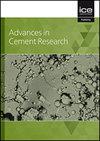相变材料(PCM)降低水泥基复合材料冻融效应的性能
IF 1.3
4区 工程技术
Q3 CONSTRUCTION & BUILDING TECHNOLOGY
引用次数: 0
摘要
目前,减少冻融效应对水泥基复合材料造成损害的方法之一是加入相变材料 (PCM)。在这项研究中,复合材料中添加了正十四烷,这是一种微胶囊有机 PCM,添加量分别为水泥重量的 0%、2%、4%、6% 和 8%。在代表土耳其两个不同地区气候条件的两个不同模拟中,确定了 PCM 对复合材料温度振幅限制的影响。结果表明,PCM 的工作范围与模拟中应用于复合材料的温度范围相近,更能成功地降低温度振幅,并且应根据复合材料希望使用的气候条件,深思熟虑地选择 PCM 的比率和类型。此外,除了 PCM 的热性能外,还研究了其对机械性能和稠度结果的影响。本文章由计算机程序翻译,如有差异,请以英文原文为准。
Performance of the phase change material (PCM) to reduce freeze-thaw effect in cementitious composites
One of the contemporary approach to reduce the damage on cementitious composite resulted from freeze-thaw effect is the incorporation of the phase-change materials (PCM). In this study, the composites were produced adding n-tetradecane, which is a microencapsulated organic PCM, at rates of 0, 2, 4, 6 and 8 % of the cement weight. In two different simulations representing the climate conditions of the two distinct regions in Türkiye, its effect on restriction in temperature amplitudes which the composite experienced, was determined. It is determined that the PCM, the working range of which is similar to the temperature range applied to the composite in simulation was more successful to reduce the temperature amplitudes and the rate and type of the PCM should be chosen thoughtfully according to the climate conditions, which the composite is desired to use. Moreover, besides PCM's thermal properties, its effect on the mechanical properties and consistency results were investigated.
求助全文
通过发布文献求助,成功后即可免费获取论文全文。
去求助
来源期刊

Advances in Cement Research
工程技术-材料科学:综合
CiteScore
3.70
自引率
5.00%
发文量
56
审稿时长
3.2 months
期刊介绍:
Advances in Cement Research highlights the scientific ideas and innovations within the cutting-edge cement manufacture industry. It is a global journal with a scope encompassing cement manufacture and materials, properties and durability of cementitious materials and systems, hydration, interaction of cement with other materials, analysis and testing, special cements and applications.
 求助内容:
求助内容: 应助结果提醒方式:
应助结果提醒方式:


